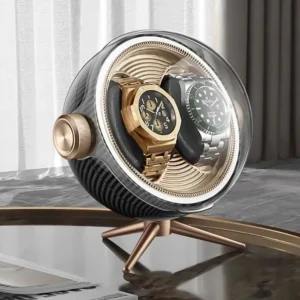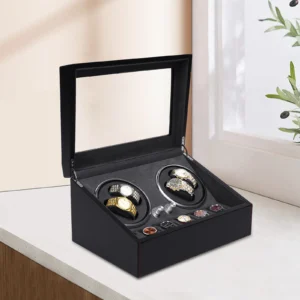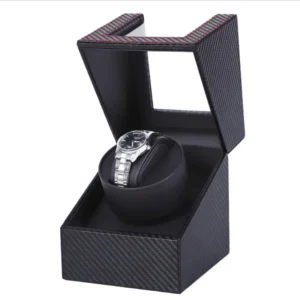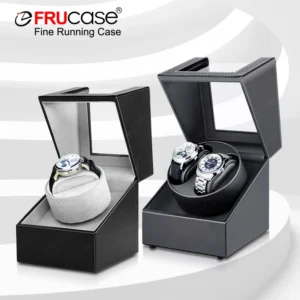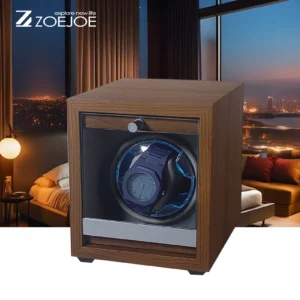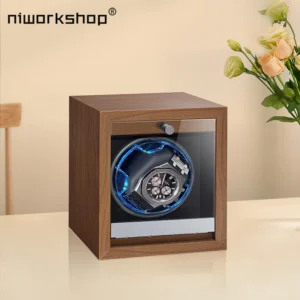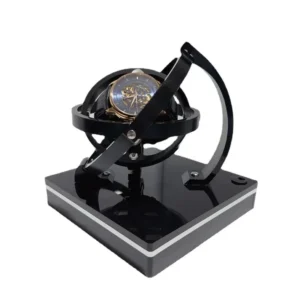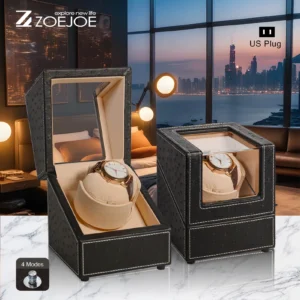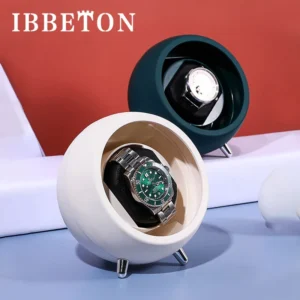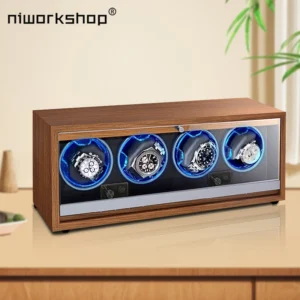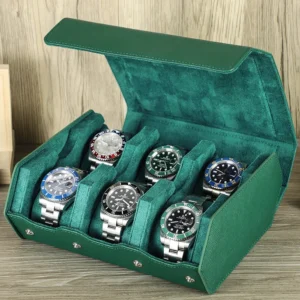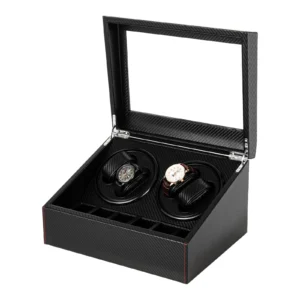Single Watch Winder
Your automatic watch needs motion to stay accurate and healthy. A single winder provides this, keeping it perfectly wound and ready so you never have to reset it.
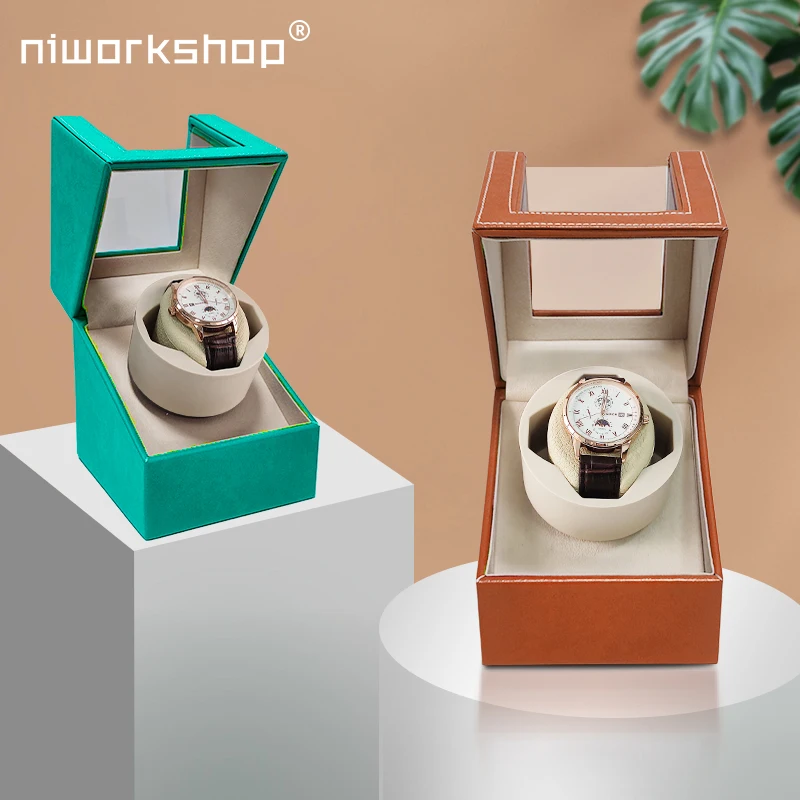
Showing 1–12 of 20 results
Automatic Watch Winder, Luxury Watch Winder, Single Watch Winder
$184.28 Select options This product has multiple variants. The options may be chosen on the product pageAutomatic Watch Winder, Luxury Watch Winder, Single Watch Winder
Price range: $322.32 through $509.59 Select options This product has multiple variants. The options may be chosen on the product pageAutomatic Watch Winder, Single Watch Winder, Watch Display Case
Price range: $213.52 through $223.65 Select options This product has multiple variants. The options may be chosen on the product pageAutomatic Watch Winder, Single Watch Winder, Watch Holder
Price range: $109.19 through $190.84 Select options This product has multiple variants. The options may be chosen on the product pageAutomatic Watch Winder, Double Watch Winder, Single Watch Winder
Price range: $123.48 through $160.16 Select options This product has multiple variants. The options may be chosen on the product pageAutomatic Watch Winder, Single Watch Winder, Wooden Watch Holder
$201.76 Select options This product has multiple variants. The options may be chosen on the product pageAutomatic Watch Winder, Single Watch Winder
$191.45 Select options This product has multiple variants. The options may be chosen on the product pageAutomatic Watch Winder, Luxury Watch Winder, Single Watch Winder, Wooden Watch Boxes
$232.25 Select options This product has multiple variants. The options may be chosen on the product page4 Watch Winder, Automatic Watch Winder, Double Watch Winder, Single Watch Winder, Wooden Watch Holder
Price range: $144.00 through $816.00 Select options This product has multiple variants. The options may be chosen on the product pageAutomatic Watch Winder, Rotating Watch Holder, Single Watch Winder, Watch Display Case
Price range: $252.01 through $253.74 Select options This product has multiple variants. The options may be chosen on the product pageAutomatic Watch Winder, Single Watch Winder, Watch Pillows
$145.51 Select options This product has multiple variants. The options may be chosen on the product pageAutomatic Watch Winder, Single Watch Winder
Price range: $110.70 through $112.00 Select options This product has multiple variants. The options may be chosen on the product page
Showing 1–12 of 20 results
Understanding Single Watch Winders: The Essential Companion for Automatic Watch Owners
Single watch winders are specialized devices designed to keep automatic watches wound when they’re not being worn. These ingenious machines mimic the natural movement of your wrist, ensuring your timepiece’s internal mechanism stays active and ready for use. Unlike manual watches that require hand-winding, automatic watches depend on motion to maintain power—making a winder an essential tool for any serious collector.
These dedicated units differ significantly from multi-watch winders in their focused approach to caring for a single treasured timepiece. While watch boxes and cases provide static storage, a single watch winder actively maintains your watch’s functionality, keeping the internal springs tensioned and the movement lubricated. At Daily Accents, we understand that proper maintenance extends the life of fine timepieces while preserving their precision.
How Single Watch Winders Work: The Science Behind the Mechanism
At the heart of every watch winder is a precision motor that creates controlled rotational movement. This motor powers a rotating cup where your watch sits securely mounted. The rotation—measured in TPD (Turns Per Day)—activates the watch’s self-winding mechanism, which typically requires between 650-1,800 rotations daily depending on the specific movement.
Quality winders offer programmable settings that allow you to customize the rotation pattern. This is critical because different watch brands and movements have unique requirements—some need clockwise rotation, others counterclockwise, and many benefit from bidirectional movement. The programmability ensures your specific timepiece receives exactly the motion it needs to maintain optimal performance.
Key Benefits of Using a Single Watch Winder
Investing in a single watch winder delivers multiple advantages for automatic watch enthusiasts:
- Perfect Timekeeping: Your watch remains ready to wear, displaying the correct time and date without needing adjustment
- Extended Movement Life: Regular motion keeps internal lubricants distributed properly, preventing them from hardening or pooling
- Reduced Crown Wear: Less manual winding means less stress on the crown and winding mechanism
- Protected Storage: Quality winders shield your timepiece from dust and environmental factors
- Elegant Presentation: Many winders double as display solutions, showcasing your prized possession
These benefits are particularly valuable for watches with complex complications like perpetual calendars, moon phases, or annual calendars—features that can be tedious to reset if allowed to wind down completely.
Essential Features to Consider When Choosing a Single Watch Winder
When selecting the perfect single watch winder, consider these crucial features:
- Rotation Settings: Look for adjustable TPD (typically ranging from 650-1,800) to match your specific watch’s requirements
- Direction Control: Quality winders offer clockwise, counterclockwise, and bidirectional rotation options
- Motor Quality: Premium Japanese Mabuchi motors provide quiet, reliable operation with minimal vibration
- Construction Materials: Exterior materials range from wood veneer to genuine leather or carbon fiber, while interiors should feature soft, non-abrasive linings
- Power Options: Consider whether you prefer AC adapter, battery operation, or newer USB-powered models
- Size and Proportions: Ensure the winder accommodates your watch’s dimensions, particularly for larger sports watches
The most versatile winders offer memory function to retain your settings even when unplugged, and cushion flexibility to accommodate different bracelet sizes and watch weights.
Matching Your Winder to Your Timepiece: Finding the Perfect Fit
Different watches have specific winding requirements that should inform your winder selection. Check your watch manufacturer’s website or owner’s manual for the recommended TPD and rotation direction. If this information isn’t readily available, watch enthusiast forums often contain databases of these specifications.
Physical fit matters too. Most single winders accommodate standard watch sizes, but if you own a particularly large timepiece (over 45mm) or one with an integrated bracelet, verify dimensions before purchasing. Quality winders feature adjustable cushions that can be compressed or expanded to secure various bracelet sizes in their closed position.
Premium vs. Budget Options: What You Get at Different Price Points
Watch winders span a wide price range, with distinct differences between tiers:
Entry-Level ($50-100):
– Basic rotation programs
– Louder motor operation
– Limited direction options
– Simpler materials and construction
Mid-Range ($100-300):
– Multiple TPD settings
– Bidirectional rotation
– Quieter motors
– Superior cushion quality
– Better material finishes
Premium ($300+):
– Japanese Mabuchi motors
– Complete programming flexibility
– Memory function
– Premium materials like genuine leather or wood
– Near-silent operation
– Extended warranties
Investment in higher-end models typically pays dividends in longevity, precision, and aesthetic appeal—important considerations when protecting timepieces worth thousands.
Setting Up and Maintaining Your Single Watch Winder
Proper setup ensures optimal performance for both your winder and watch:
- Place your watch on the cushion with the crown facing in the direction specified in your winder’s manual
- Secure the watch by gently compressing the cushion if it’s adjustable
- Program the TPD and rotation direction according to your watch’s specifications
- Position the winder on a stable, level surface away from direct sunlight
For maintenance, periodically dust the exterior and ensure ventilation areas remain unobstructed. If your winder uses batteries, replace them promptly when depleted to prevent potential leakage that could damage the mechanism.
Ideal Placement and Environment for Your Watch Winder
Your winder’s environment significantly affects its performance and longevity:
- Temperature: Maintain room temperature between 68-77°F (20-25°C) to protect both the winder’s electronics and your watch
- Humidity: Keep relative humidity below 60% to prevent potential damage
- Lighting: Avoid direct sunlight which can fade materials and create excess heat
- Stability: Place on a solid surface away from areas with frequent vibration
- Aesthetics: Consider positioning your winder as a display piece on a desk, nightstand, or within a watch cabinet
Many collectors integrate their winders into their home décor, selecting finishes and styles that complement their interior design aesthetic.
Single Watch Winders as Elegant Display Solutions
Beyond their functional purpose, single watch winders serve as sophisticated display pieces that showcase your horological taste. Available in various designs, they can enhance any interior:
- Classic Wood Finishes: From rich mahogany to blonde maple for traditional settings
- Modern Materials: Carbon fiber and brushed aluminum for contemporary spaces
- Luxury Leather: Genuine leather exteriors in various colors for elegant presentation
Premium models feature glass viewing windows and subtle LED illumination that highlight your timepiece’s details while keeping it perfectly wound. These design elements transform what could be merely functional storage into a celebration of watchmaking artistry.
Common Questions About Single Watch Winders
Are watch winders necessary for all automatic watches?
While not absolutely required, winders are strongly recommended for complicated watches and those worn in rotation with other timepieces.
Can a watch winder damage my timepiece?
Quality winders with proper settings won’t damage your watch. Incorrect settings or overuse of low-quality winders could potentially cause excessive wear.
How long can I leave my watch on a winder?
Most fine watches can remain on a winder indefinitely when using appropriate settings, though periodic wearing is beneficial.
What’s the difference between a single and multi-watch winder?
Single winders focus on one timepiece with dedicated settings, while multi-winders accommodate multiple watches, sometimes with independent settings for each.
Are watch winders noisy?
Premium winders with quality motors operate nearly silently, while budget options may produce noticeable sound.
Choosing the Perfect Single Watch Winder: A Timeless Investment
Selecting the right single watch winder represents an investment in preserving the precision, functionality, and value of your automatic timepiece. By balancing technical requirements with aesthetic preferences, you’ll find a winder that serves both practical and display purposes.
Quality winders from Daily Accents provide peace of mind, knowing your cherished timepiece is maintained in optimal condition between wearings. With proper care, both your watch and its winder will provide years of reliable service, enhancing your collecting experience and protecting the significant investment you’ve made in fine horology.


